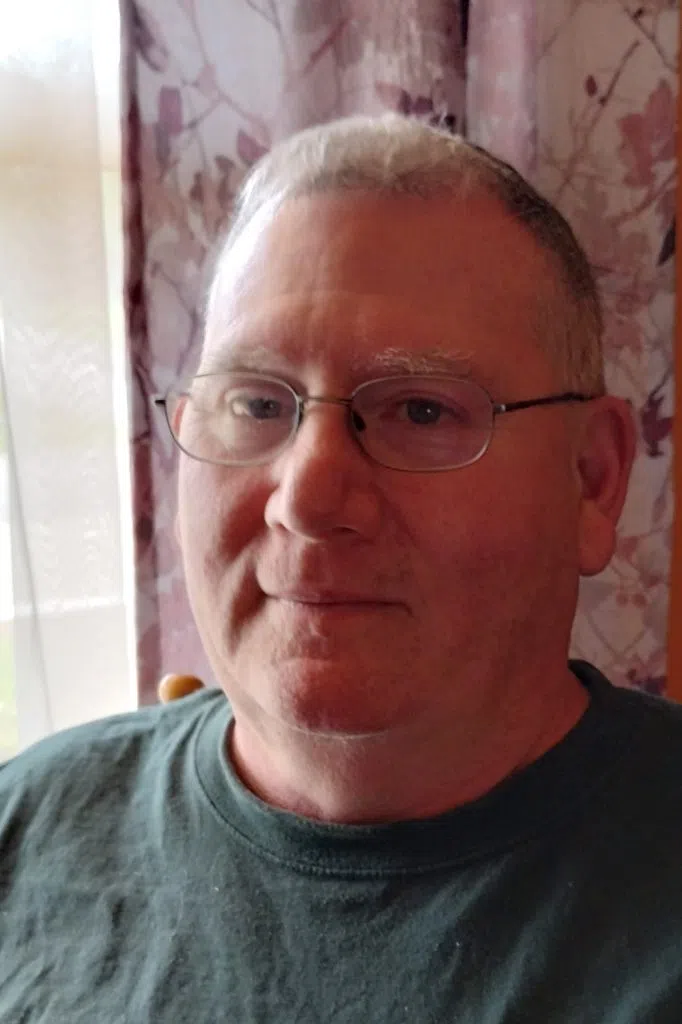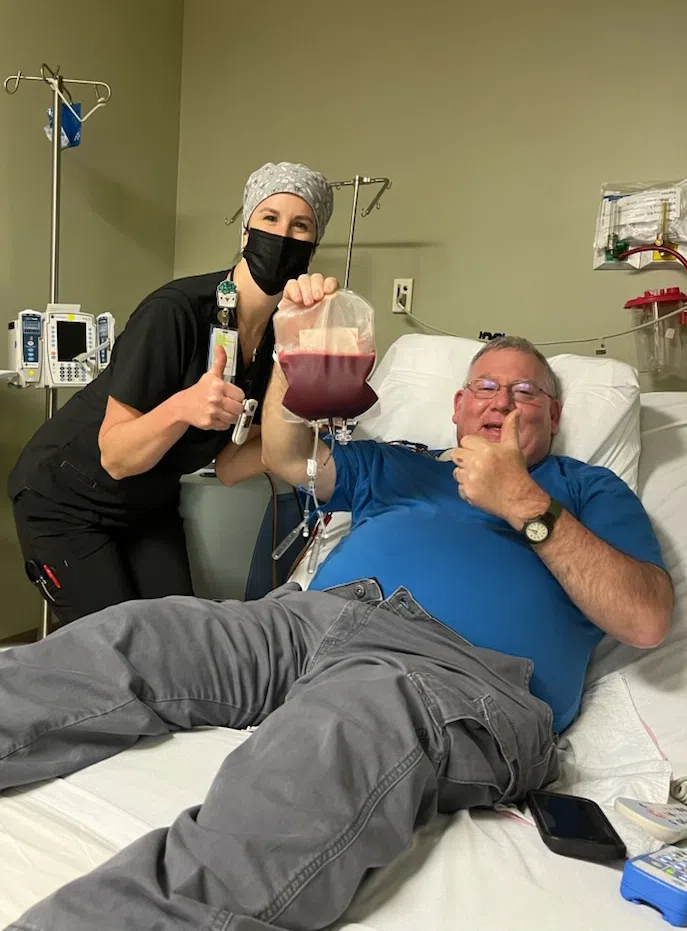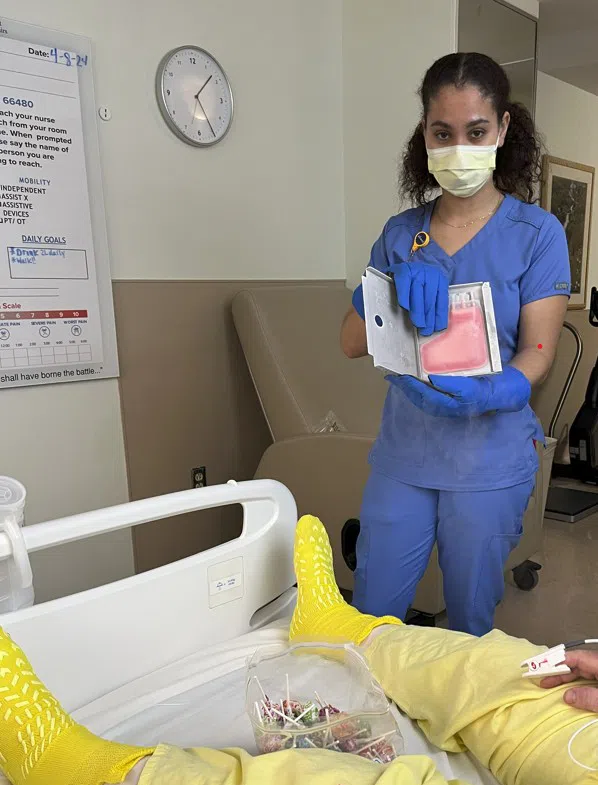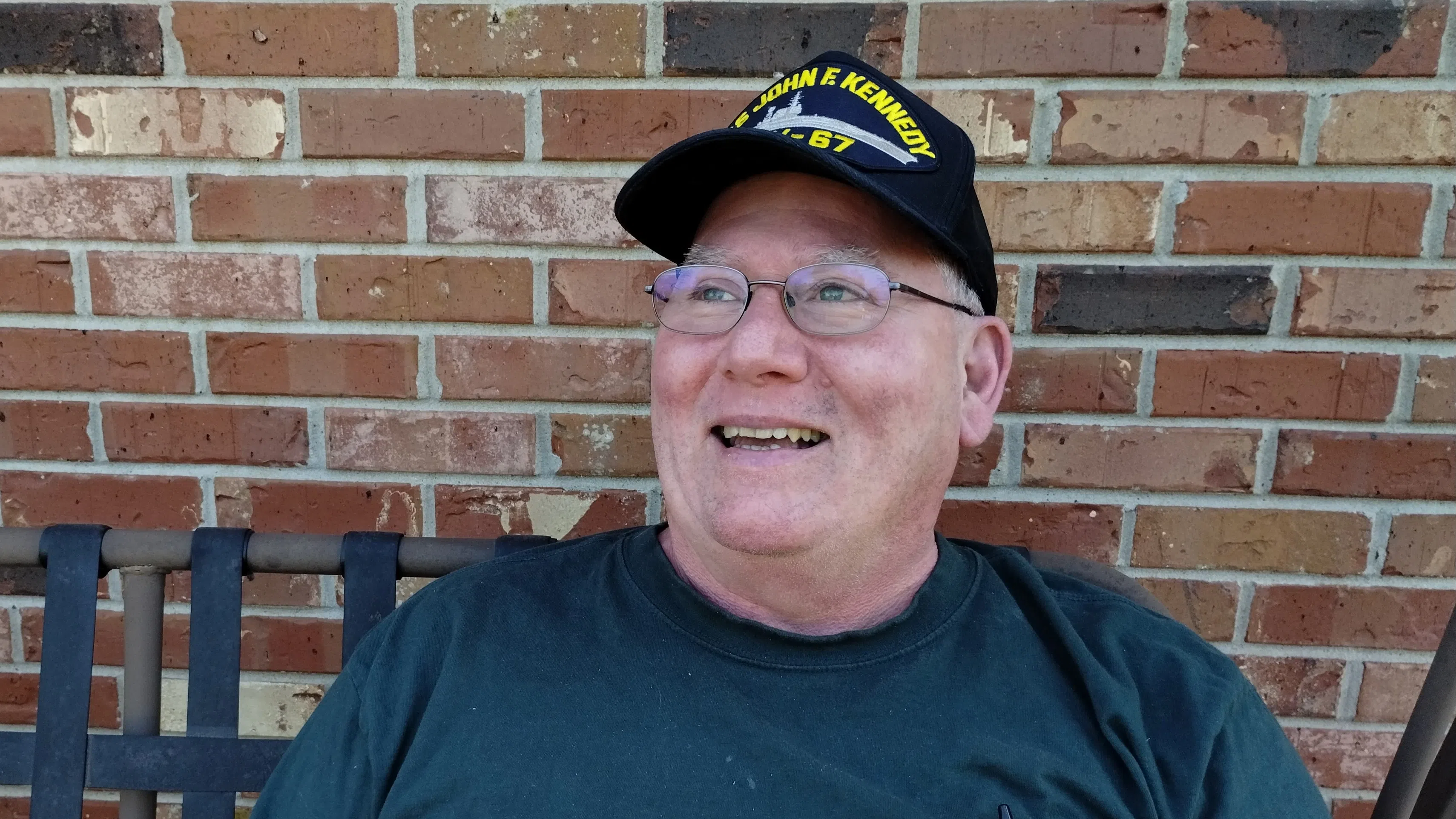By MELINDA J. OVERSTREET
for Glasgow News 1
In September 2023, he had been fighting a cold for weeks and weeks. His immune system was depleted.
“It got to the point that I was really struggling to breathe,” Alex Jerome Hatcher said.
When he went to see a doctor, he sent him for x-rays. Hatcher said that when he’d had a similar problem a couple of years earlier, he’d gotten a shot, a prescription for an antibiotic and was back to work the next day, so that’s what he was expecting this time. The images led to a diagnosis of pneumonia.
“So that’s an automatic hospital stay there,” he said. “I guess I was weaker than I thought I was.”
But they had also spotted something else on the x-ray that caused concern, so they did a computed tomography, or CT, scan while he was there at T.J. Urgent Care, Hatcher said.
They told him it appeared he had some type of cancer and it had spread. From there he was taken by ambulance to T.J. Samson Community Hospital, where more tests were performed. Based on all the information gathered, the oncologist there at the time, Yashpal Modi, told Teresa the following day while Jerome was sleeping off one of those tests that Jerome had symptoms of multiple myeloma, a type of cancer that develops in plasma cells in bone marrow.
As it turned out, his cancer was in Stage 3 – the final one for this particular illness – and it had already metastasized and spread throughout his body, the Hart County resident told Glasgow News 1 in the living room of his mother’s Glasgow home. His mother, Margaret Sue Blaies, and wife, Teresa Hatcher, were seated nearby and helped occasionally as he shared his story of the arduous journey that had gotten him to that point.

Jerome Hatcher sits in his mother’s home after reflecting on his journey with multiple myeloma with Glasgow News 1. Melinda J. Overstreet / for Glasgow News 1
Hatcher had the most common type of multiple myeloma – IgG kappa, according to the International Myeloma Foundation. The Ig stands for immunoglobulin; all multiple myelomas are named for abnormal immunoglobulins. Immunoglobulins, also called antibodies, are a type of proteins that plasma cells produce that are essential in the body’s fight against bacteria, viruses and fungi. A deficiency can lead to recurrent infectious diseases or other problems, according to the National Center for Biotechnology Information that is part of the National Institutes of Health.
Hatcher’s type was also determined to be “light chain,” which occurs when myeloma cells only produce immunoglobulins with light chains and no heavy chains, according to the International Myeloma Foundation. This aspect affects only 15 percent to 20 percent of patients, according to the foundation.
Signs and symptoms
Jerome said a cluster of conditions that can help identify multiple myeloma is identified with the acronym CRAB. Patients with this type of cancer often exhibit signs of calcium elevation (hypercalcemia), which he said is because the calcium is going from the bones into the blood; renal failure; anemia; and bone lesions or bone pain. He had all but the renal – or kidney – issues, and he’s grateful that his are still OK, he said.
The multiple myeloma significantly weakened his bones, though. He had actually started having significant problems with his back in July 2023, but as someone who’s work required a lot of heavy lifting, he chalked a lot of it up to that and maybe some to his age of 60. Since then, he said, he’s lost 4 inches of height due to compression fractures in his back, and he also has a rib with a fracture in it and innumerable lesions on his bones. He’s very concerned about having a fall due to the possibility of reduced bone density.
Slow steps toward better health
It took about four days at T.J. Samson Community Hospital to get past the pneumonia with his depleted immune system caused by the myeloma, after which his doctor told the U.S. Navy veteran to go directly to a Veterans Affairs emergency room, and he went to Lexington.
Jerome said that to have treatment at a non-VA facility requires a seven-day preauthorization, so that’s why he needed to go directly to the VA about the myeloma.
“They started me on the chemo there and did the first biopsy,” Jerome said. “It showed about 50 percent cancer cells in the bone marrow, and in order to do a transplant, they wanted to get it down to, like, lower than 10 [percent]. So they started me on chemo there, and I was there for about four days and then came home. I was so weak, I could not walk up my steps at our house.”
He double-checked with Teresa on the timeframe before adding they spent four and a half months at his mother’s home, because it was easier to navigate.
“I slept in that hospital bed right in there,” he said, pointing to the bed still there and visible through a doorway. “I had to have help getting in and out of the bed. I was really weak.”
He went to the VA in Nashville – one of only three places in the nation that do bone marrow transplants, in close conjunction with Vanderbilt University Hospital – for a pre-examination for transplant viability early that December, but he wasn’t quite ready then, and they kept him on the chemo and scheduled the transplant for February.
In January, though, they found out Teresa needed emergency open-heart surgery for a valve replacement, and they waited four weeks after her operation before heading to Nashville for 45 days.
Transplant preparation
If an appropriate match can even be found, transplanting bone marrow from another person brings significant risks to the patient on top of what the cancer may be doing to them, Jerome said, including having the body reject the transplanted marrow.
Medical advancements have now made it so that in the majority of cases like his, the patient becomes their own donor, he said, but it’s a lengthy process and not without risks of its own.
Once in Nashville, he went through numerous tests over about 10 days to make sure he was still a good candidate, including an electrocardiogram to make sure his heart was strong enough to pump the blood through his body. They also did additional bone-marrow biopsies, with the first showing a cancer-cell percentage around 25, and the second one was close to 5 percent, so he had hit the target level at that point.
Two days before the transplant, he went through a 6.5-hour process called apheresis. The patient’s blood is removed through tubes and then processed through a machine that extracts the stem cells – with a goal of at least 6 million of them – and the rest of the blood material is returned to the body. Jerome said the blood is completely cycled through 10 to 12 times.

Jerome Hatcher holds up a bag of stem cells that had been extracted from his blood through a process called apheresis, which he underwent in April 2024 at the VA hospital in Nashville prior to getting some of those same cells reinfused into his body in an autologous stem cell transplant. The process is used to treat multiple myeloma, a type of cancer. Submitted photo
Then he had to take an “old-school” chemotherapy treatment called melphalan – a dosage that would normally be administered over nine weeks done in the next two days – to kill the blood cells remaining in the body, Teresa said.
Only after all that, a day or two after the chemo, does the actual transplant occur. Up to this point, while in Nashville, they had been able to simply visit the hospital each day while staying at a hotel about a mile away where they were provided with lodging. The side effects from that treatment – no appetite, nausea and hair loss – didn’t hit until two to three weeks later.
Transplant time
Of the 10 million stem cells that had been extracted earlier through apheresis and then frozen, roughly 9.5 million survived that process. Of those, five million – in about nine pouches – were thawed and then promptly reinfused through a port tube placed into Jerome’s body through his forearm, leaving 4.5 million to remain in frozen storage at Vanderbilt for any potential future transplant that might be needed. He said that part only took about half an hour, and it didn’t feel cold as one might expect. Instead, he felt a hot, flushing feeling at first but then he got used to it. Otherwise, Jerome said, it was “uneventful.”
Teresa said, though, that either process, the apheresis or the transplant could cause a person to go into shock and die, because it’s so traumatic for the body.
In a process that’s going well, within 12 to 15 days of the transplant, the white cells start really multiplying more, and it took his longer than usual to do as much. Even after that, it typically takes 12 to 14 months for the immune system to rebuild itself.
One of the risks of this process is neutropenic fever, creating dangerously high temperatures, and it happened to Jerome about three days after the transplant. He’d only had to stay overnight after the transplant, and after the doctors made their rounds the next day, he was allowed to go back to the hotel room, but he was only there about half an hour, he said.
His fever spiked, and he’d been warned to return right away if that happened. He spent the next two days at the hospital before being discharged, but then again had to return, this time for 13 days. His heart rate stayed high a lot during that time as well.
Once he was able to stabilize from that, the couple returned to the hotel to continue his recovery process, with frequent returns to the hospital for status checks for several more days.

A healthcare provider holds a bag of stem cells that had been extracted from Jerome Hatcher’s blood a few days earlier and frozen. About nine pouches’ worth of those cells were about to be reintroduced to his bloodstream as a way of treating multiple myeloma, a type of cancer he was diagnosed with in 2023. Submitted photo
While the apheresis wasn’t exactly enjoyable, he said it was the biopsies that were really painful, because they had to drill into the bone to take the samples, Jerome said. Most of the times it was done, it had to be done more than once because they weren’t getting enough.
Helping hands
Jerome said the VA took good care of him during their stay in Nashville, and Teresa said they did the same for her, as she was still recovering from her heart surgery, during their stay in Nashville.
“The staff down there, I was in really good hands,” he said.
He added that they kept them well informed about everything that was happening and was expected to happen, and he didn’t feel they were “in the blind about anything.”
“If it wasn’t for the VA, we wouldn’t have been able to afford to – I mean, I couldn’t have had nothing done,” he said. “They took care of everything.”
Teresa said the local oncology staff was very good as well.
She was worried when Modi moved away during their Nashville stay but then relieved as she learned that Florin Andreca, the new cancer and blood specialist among the T.J. Regional Health physicians, had a considerable amount of expertise and experience with myeloma.
Through this journey, Jerome also got some important extra help through Community Medical Care, which is under the umbrella of T.J. Mission Foundation in Glasgow.
One of the services offered through CMC’s Breaking Barriers to Care initiative provides gas gift cards to cancer patients. The Hatchers live in the Bonnieville vicinity, so it was about 60 miles for every round trip just to and from Glasgow for tests and checkups.
“Those gas cards they have, that was really beneficial to us,” Jerome said.
When he had pneumonia and then during the subsequent trip to Lexington, he went from about 240 to 218 pounds and had no appetite. That’s where the Breaking Barriers service that helps with liquid nutritional/protein supplements, sometimes called shakes, helped. Sometimes they were the only thing he could get down and/or that would stay down. Teresa said the cost of those was about a fourth of what it would normally be through this program.
He said those were a really big help; he started putting weight back on within a week of starting to drink those Boost supplements.
Jerome and Teresa mentioned that many had prayed with them and for them, and they believed they could feel that power.
Looking forward
After the transplant, he continued to wear a protective mask for quite a while because of his weakened immune system and had only stopped doing so around May of this year, and his health has continued improving since then.
Over the course of those nine months, he had a total of five biopsies, with the last being in July 2024, when no active cancer was detected.
“So that’s a good thing,” Jerome said. “It’s not curable, so, I mean, … you know, it will come back later. And that’s why they saved half the [stem]cells, in case we have to do another transplant.”
Over time, he also got standard immunizations again, as the process would have wiped out any immunity built from previous ones.
He takes a maintenance medication – a pill every day – called revlimid that helps suppress the myeloma protein, he said. It also helps the immune system fight any cancer that may try to return. He has to be tested every three months while taking this medication. The main side effects he has experienced from that are dry skin and/or a rash and, somewhat ironically, weight gain.
“I feel good. I’m here, and I’m getting stronger,” Jerome said.
He also gets blood drawn every month to check his blood count and calcium levels in particular, and he also gets shots to help build the calcium in his bones to help prevent further fractures or other bone problems.
Jerome and his father-in-law started Matthews Concrete on June 4, 1990, and Teresa’s father retired in 2010, she said. Jerome said he had planned to work another 10 years before retiring himself. His health concerns led to the decision to sell the business, though, so he and his wife can try to take better care of themselves – an opportunity they may not have had a few decades earlier.
“Forty to fifty years ago, this was a death sentence because they didn’t have the transplant technology,” Jerome said.
……………………………………………….
TO LEARN MORE
International Myeloma Foundation – Types of Myeloma
_________________________________________________________
CARE Power Hour is an event to celebrate cancer survivors, their families, caregivers, providers, and friends. The lavender ribbon is a general symbol of awareness for all cancers. It serves as a unifying symbol, promoting empathy and support for anyone affected by cancer regardless of the specific type. Proceeds from CARE Power Hour directly benefit Community Medical Care’s Breaking Barriers to Care Program, which provides assistance to cancer patients for the most common barriers to care such as transportation and supplemental nutrition. Purchase tickets to the event here.

Comments